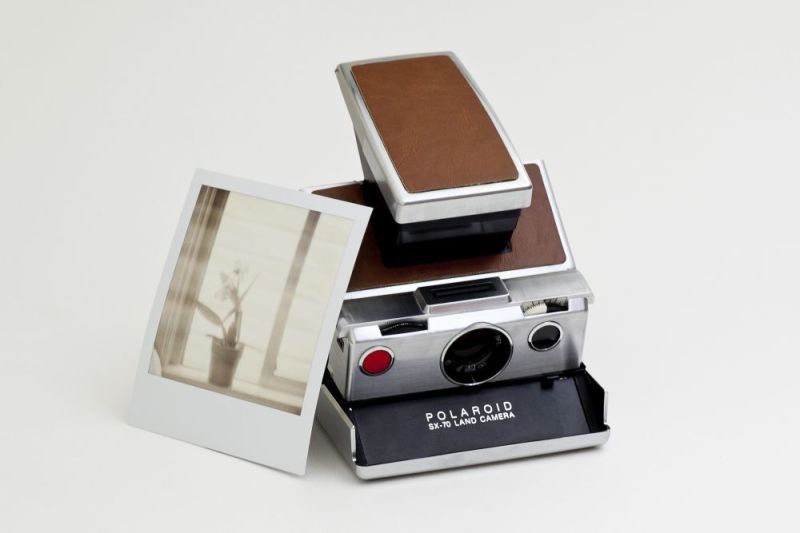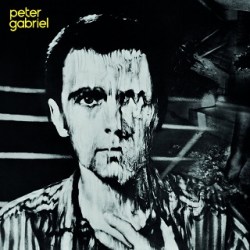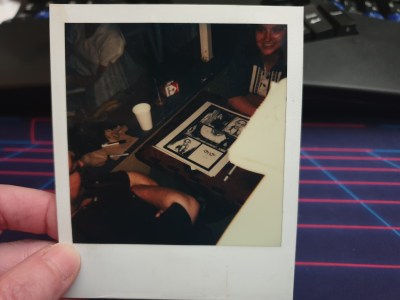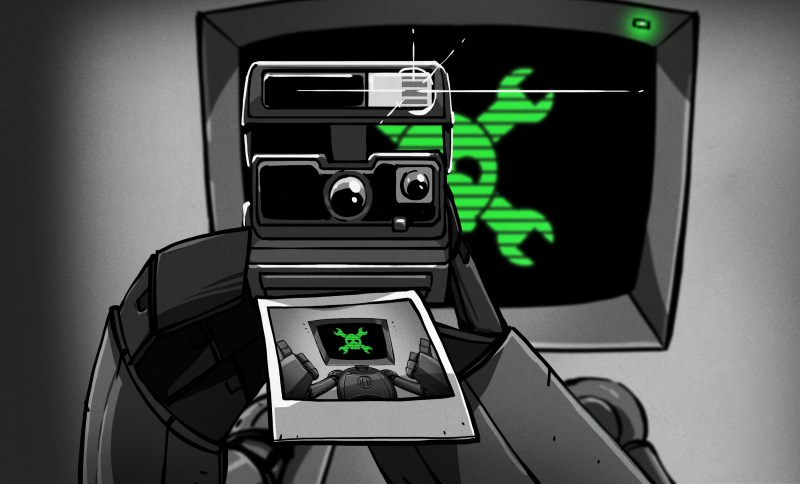Today, most of us carry supercomputers in our pockets that happen to also take instantly-viewable pictures.This is something that even the dumbest phones do, meaning that we can reasonably draw the conclusion that photographic capability has become a basic feature of everyday carry, a necessity of 21st century life.
Despite the unwashed masses of just-plain-bad photographs clouding the digital landscape, photography itself remains as important as ever so we can retain and disseminate information as history unfolds. In a sense, the more instant, the better — unless it comes at the cost of image quality. The invention of photography is on par with the printing press or with language itself in that all three allow us to communicate within our own time as well as preserve The Way Things Were in frozen silence. And no invention made vivid preservation more convenient than the instant camera.

Instant Memories

This year, the iconic Polaroid SX-70 turns 50 years old. This was the first truly instant SLR camera, an engineering marvel containing over 300 transistors. Every film pack had a battery inside, so in theory, no moment would go uncaptured.
Polaroid began producing instant-film cameras in 1948, but for the first 25 years or so, the developing process was quite involved. With the advent of the SX-70 in 1972, one could freeze a moment in time and hold it in their hands a minute or so later. And miraculously, the device itself folded down into a 1″ slab that would just barely fit in the jacket pocket of your leisure suit.
Things got easier for the user from there, until all you had to do was pull the picture out of the front of the camera and lay it flat to dry (because you really shouldn’t shake them). But if you wanted to mess with the outcome, it was fairly easy to manipulate the still-wet developing chemicals to great impressionistic wavy effect. Way more fun than a filter, no? If you can get your hands on one of these originals, check out the Open SX-70 Project.
Impossible Resurrection

Polaroid began to decline in the 1980s alongside the rise of cheap 35mm cameras and one-hour photo labs, but to this 80s kid, instant cameras were still half novelty, half luxury, and completely awesome. The company emitted a last gasp in the form of 1999’s i-zone camera, a small instant that produced tiny pictures on decorated film strips. I have two of them; they were great. More fun than a Fun Saver, and probably more expensive, too.
Try as they might, Polaroid just wouldn’t go away. They went bankrupt twice between 2001 and 2008, were sold three times, and one parent company got caught up in a Ponzi scheme. But the iconic brand was both saved and renewed by aficionados under the name the Impossible Project. They scooped up the last factory and spent years reformulating the original developing chemicals until they got it right. Eventually, they unified the brand with Polaroid and started selling new instant cameras that pay homage to the past. Here’s a look inside the factory:
Tangible But Frangible
Whether physical photographs are developed instantly, in one hour, or over the course of a few days, one thing binds them all, and that is tangibility. You can write on the back, send it off in a letter, use one as a bookmark, or carry a few around in your wallet. Physical photographs are dual time capsules — they freeze an otherwise-lost moment, and then the picture itself becomes a time capsule of its own, counting down until the medium disintegrates.

Instant-gratification photography is one thing, but add in tangibility and you have something special. Of course, digital files also age, but we can’t sense this passage of time the way we can use physical clues to date aged photographs. In digital form, pictures become files that just get corrupted and/or can’t be opened. It’s still in your hands, yet gone forever.
Of course with physical photographs, it’s much easier to lose the only print in existence. I can’t tell you how many times I’ve bought a used book and found a photograph inside. I always hope that it wasn’t someone’s only copy.
We monkeys marvel at our digital devices that can take a single image and proliferate it into an unstoppable force that can never be erased from the digital walls of the Internet. But the instant camera in particular gave us something else: privacy without the need for a darkroom. Suddenly, you could take a picture of anything without worrying about what someone else would think. Making duplicates negatives, and as long as you hold those (or they don’t exist), you’re blackmail-proof no one is getting any unauthorized copies. Was this development ultimately good or bad for society? Well, that’s another rant altogether. But surely there’s nothing inherently bad about privacy, right?
Thanks for the tip, [Ostracus].

















The original folding SLR SX-70 is an absolute masterpiece of industrial design. And a lot of them are still working great 50 years later thanks to the amazing work Impossible Project has done keeping the film manufacturing process alive.
We only have “supercomouters” in our pockets because they are way better than okd comouters. Now, they are “average”. Suoercomputers today are beyond our reach.
I oncem found a damaged Polaroid camera. It was digital, but had a built in printer at the front. It was even styled like old Polaroids.
Some might say supercomputers of yore are close at hand.
In the early instant print process, the picture came out of the camera and you had to peel off the cover, exposing the still wet print to the air. People used to wave it around in the air to get it to dry. I recall there was also a glaze that was applied with a sponge/squeegee type thing, also wet, that I think was primarily to make the print surface shiny, but may have protected it from UV degradation.
In the 80s and early 90s the process advanced and you no longer had to peel the cover off of a wet print. The thing came out of the camera sealed. But that didn’t stop people from waving them around in the air, with no idea why they were doing that. Doh! I used to laugh …
I used to wonder why people were waving them around. Now I know the origin of the practice! I always chuckled when I saw people waving and waving it all about… :)
It was never a mystery for those who experienced the early Polaroid cameras.
I agree. We got one just after they first came out, and where often waving them around.
One interesting thing is I still have prints from that time – I scanned them in decades ago but still have the originals – and they are surprising still viewable.
in the 80s i had a polaroid supposedly used by movie studios to take promotional still and to check lighting. 110? it had a schneider or rodenstock 135? 137? mm lens as used on field and view cameras and produced a black and white positive. it was completely manual and the lenses were razor sharp although the film didn’t have enough resolution to take full advantage of it. there was even polaroid film for it which would produce an actual negative so you could make your own print and since i did nearly all of my developing and printing, that was the film i preferred although the negatives were a nightmare to work with, thin and fragile.
When I was a kid, we used old school Polaroid cameras and Vegas Vacation style oversize IDs to make our McLoven IDs.
SX-70 style made a mess if you trimmed them down to drivers license size.
If Polaroid-style film could be made with a matte finish and tighter grain, it might be better for scanning, making it more practical in the modern world.
I should think that a much of SX-70 camera housing could be 3D printed, at least a One-Step.
I had a SX-70 Alpha SE, with the ultrasonic. It was black and cool looking, but the bulk from the Sonar made the camera not as sexy as the old SX-70. The pics I took with it look about the same as they did in the late 1980s
I often think of the Polaroid picture as the original NFT. Since there was no negative and the original (in the SX-70 versions) was sealed into the frame, it was a safe bet that a given Polaroid was the one and only representative of the instant shown. No duplicates, no retouching, no cropping allowed. I remember them being very popular with police and insurance investigators, perhaps for that very reason.
The instant nature was more important.
In 1980 I got a 35mm viewfinder camera. I took a bunch of pictures that summer, then it tapered off. I’d want one or two pictures, so either wait till I finished the roll, or waste the rest of the roll. Development was fadt at that point, but not instantaneous, and it added up.
Polaroid film was more expensive, but it gave you instant results. Police work likely wanted that. Same with continuity on movie sets. A photo ensures you’ll set it up the same way, and no need to wait for development
as someone who has been in photography for over 55 years and who bought the sx-70 when it was released and who eagerly bought a refurbished one from mint (who needed to have been mentioned in this article), the film produced by impossible is barely a pale shadow of a hint of a memory of what polaroid film was capable of. but the majority are so happy to have any film at all that they won’t accept any criticism. /guy
The new BW film is in my experience significantly better than their colour film. Granted, the new film still has issues with with corners and edges, but given that the only alternative is instax with their toy cameras, what can one do ?
OP told you what one can do, but here’s some links.
from mint camera:
instax wide rangefinder: https://mint-camera.com/rf70/
instax square rangefinder: https://mint-camera.com/sf70/
instax mini TLR: https://mint-camera.com/tl70/
nons camera also makes SLR for instax that take EF mount lenses (or other lenses via adapter)
instax mini SLR: https://nonscamera.com/products/nons-sl42-black
instax square SLR: https://nonscamera.com/products/nons-sl660
lomography:
instax mini: https://shop.lomography.com/us/lomo-instant-camera-lenses-black-edition
instax square: https://shop.lomography.com/us/lomo-instant-square-glass-camera-black-edition
instax wide (zone focus): https://shop.lomography.com/us/lomo-instant-wide-camera-lenses-black-edition
if you have a 4×5 view camera… lomography also makes a 4×5 graflok back that exposes instax wide: https://shop.lomography.com/us/lomograflok-4-5-instant-back
this seller on ebay makes 3d printed backs and kits to DIY: https://www.ebay.com/str/appalachianfleamarket/Custom-made/_i.html?store_cat=39136361011
there’s also a huge community of hackers who DIY instax and polaroid backs for all kinds of cameras…
Mamiya RB67 or other medium format cameras fit instax square nicely, for example.
there are lots of projects on hackaday, even: https://hackaday.io/search?term=instax
ISTR there was a Polaroid film that produced negatives…not for consumers though.
We used the old B&W peel type for oscilloscope photos in the lab. Rarely, of course, because the film was so expensive.
I bought an SX-70 and took a few pictures of my kids with it…until my son opened it and couldn’t figure out the trick to close it, then forced it closed…and that was the end of that camera.
The oldest Polaroid print I have is of my dad, on a plane to Morocco, in the late 50s, early 60s. It has scalloped edges and the clear lacquer has been imperfectly applied, so some of the image has faded.
Yes, there was a whole other use the public never saw. I recall ads in the late sixties in Scientific American for ID photos, likely special cameras.
We used that setup at my college in the mid-seventies to make ID cards. The special Polaroid camera created two images of the kid getting his ID picture taken through a mask in the camera of the ID card on color Polaroid film. We’d make the exposure then lift up on a slide that ejected the film pos/neg sandwich that dropped out of the camera through a hole in the base, onto a conveyor belt. The sandwich traveled along on the belt and when it emerged from the end of the box, the required developing time had passed. We’d peel the sandwich apart, place the picture into a cutter that punched out the two cards. One went into a box for file, the other got put into a small plastic pouch and yet another machine heat-sealed the open edge and voila! Here’s your ID card. I did that for 3 years I think. I started out working the puncher or sealer machine, and worked my way up to operating the camera.
My favorite Polaroid film is/was PN 55, which was amazing b/c it gave you a print _and_ a negative in one shot, both instant. I haven’t shot any in 15 years, and according to the interwebs, it doesn’t really exist any more.
It came in 4×5″ sheets — toss it in your grandfather’s old Speed Graphic, don your fedora, and you look like the old stereotype of a press photographer from the 1950s.
But if you want to see something cool: https://en.wikipedia.org/wiki/Polaroid_type_55
You’ll be happy to learn that someone replicated PN 55, and called it – appropriately enough – New55! You’ll be less happy to learn that it’s $75 for a pack of 5 pictures/negatives.
Ouch! I was always apalled by the old price, which was like $30 for a 10 pack… But those were 2003 dollars. :)
Looking around, I actually have a framed print of a pinhole photo I made with PN55 on my wall. It was amazing for that application b/c it’s a big negative and relatively sensitive film. I’ve never done anything but contact print it, but it’s a nice image. Wonder if anyone has a 4×5 enlarger these days…
My late dad had one. I think it’s still in his attic. Next to his mass spectrometer.
Packrat genes are strong in our family.
We tried hard to convince him to junk the mass spec, 1980s. Mom can’t move it, so I know where it sits. (KCMO if anybody wants it. _Magnets_ and vacuum pump!)
You are my brother! :)
Something nobody says about Polaroid pictures: they were expensive.
I had a camera once, and I rarely used it, because the cost of the film was staggering, compared to 35mm. There’s no way an average family would take dozens of Polaroid pictures at Christmas.
It was fascinating that you could see the picture instantly. Everything else about it was annoying.
I worked for JCB Excavators in the late 1960s, in the Test Department. We instrumented the machines with strain gauges, pressure transducers, etc., which were fed through a 19″ rack of amplifiers in the back of our van. For very fast signals the only way to record them was a special monochrome Polaroid that fixed over the front of an oscilloscope. Slower signals were recorded with a device which used the signal to deflect a galvanometer with a mirror, reflecting a UV source onto a continuous roll of sensitive paper. Both systems needed fixing for long term storage – the squeegee thing for the Polaroid, a yellow aerosol spray for the paper.
Most polaroid film was consumed in commercial photography studios to check the setup on medium and large format cameras before committing to exposing kodachrome (or similarly expensive) film. Digital imaging completely removed that assurance requirement because you can see what you are going to get instantly and there’s not much cost in taking many extra shots as you tweak the lighting etc. The domestic sentimental aspects of polaroid film were entirely incidental to its commercial purpose. When I first started in digital imaging the workstations cost as much as the average house did, back then we also had a lot of polaroid film to play with as the guys warehousing it would give us all of the stuff that was out of date and couldn’t be sold, even though it was perfectly fine for trivial use.
Sorry, most Polaroid film was used to take pictures you would not want to take to the lab for processing. Don’t ask me how I know.
+1
though by the early 80’s I found a mini lab with an owner with the appropriate attitude..
I worked at one of those labs, early 90’s. Good times!
So is THAT why one of the models was called the Swinger?
I’ve see the ones that some people did send to the labs, and worked with the people who redirected some to the police.
The Fujifilm Instax Evo camera is a digital instant film camera. You get to look at the picture before you commit to printing it. Not only that but iPhone pictures can be sent to the camera for printing. Plus it has a bunch of filters built in. Its a great camera that isn’t super sharp but way fun to use. People go crazy when you give them a print. They wave it around and then very carefully put it away so they can keep it forever.
Just buy a canon selphy printer and you get better pictures at a cheaper price. That Fujifilm camera is, i am sorry to say, a POS.
There is also the Lomo’Instant, including versions with swappable lens
Tell me more about why you dislike the Fuji. I’ve got my eye on the Mini 40.
The Impossible film only has 8 shots VS the original Polaroid’s 10. Why? Because they couldn’t make them as thin as the original. But even with their new Polaroid camera that has a built in battery so the film packs don’t have to include one, they still only put 8 shots in their batteryless film packs that only work in the new camera.
The new camera can use the packs with the battery but AFAIK it doesn’t use that battery.
I used to break open the used film packs to extract the flat Polapulse batteries. Originally the battery was the full size of the film but later ones were shrunk down to an area in the center. IIRC those had much less leftover power. I assume the goal was to have the battery made with just a bit more juice than it would take to run the camera for 10 shots.
I rigged up an old 6V lantern battery flashlight to use the used Polaroid batteries. But that was way back in the 1980’s.
Dry cells last longer with lower drain or longer recovery between uses, so a shot every few days, in natural light needing no flash, would use about a quarter to a third the capacity probably, whereas 10 flash shots back to back would pretty near kill it, though there would probably be a safety margin for maybe a year of self discharge or something.
I used to rig up an old TRS-80 Model 100 to run off of one of those batteries, just because I could. I also ran it off of a lantern battery for a while.
The batteries in the cassettes nowadays easily put out over 10 amps after the film runs out. Can imagine they still could run lanterns radios etc
In 1970, while searching through photography books in the basement of the M.I.T. science library, I saw that all the books dealing with photographic chemistry had been checked out by the Polaroid Corporation some number of years previously. I guess they were searching for forgotten or obscure technology that would be useful for their upcoming color product.
Early Polaroid color prints produced a very poor red, but this problem was eventually solved.
I’ve wondered if the ability of this camera to take very personal, intimate pictures with no need to send them out for developing was why it got the otherwise arbitrary “SX” designation. Just a thought…
No, but the earlier one was called a Polaroid Swinger.
The jingle for the Swinger commercial was going through my mind as I read the comments.
“Meet the Swinger,
the Polaroid Swinger,
a brand new camera,
It’s almost alive.
It’s only Nineteen Dollars and Ninety-five!
Pick it up,
It says “Yes”,
Take the shot,
count it down,
zip it off”
(as best as I can remember it)
Yep, that’s how it worked. You’d squeeze the release button and turn it while you looked through the finder. In a window below the viewfinder was another window and as you turned the button eventually a red “YES” would appear when the exposure was right. Push down the button to take the picture, then pull the film sandwich out and tear on the dotted line to tear that picture off the roll. Wait for a minute and peel it apart, and there’s your picture. Do your waving to get it dry then smear the sticky coater on it and wave some more until that dried too. I was given one of those for an Easter present when I was in 6th grade, and I still have pictures taken with it. In fact, the camera in its case is in a trunk in the spare room.
HaD readers might be interested in reading about Elsa Dorfman, the large-format Polaroid portrait photographer. Talk about a technical challenge!
https://www.nytimes.com/2020/06/02/arts/elsa-dorfman-dead.html
The best Halloween I remember, I took every kids picture and gave it to them as a treet.
I remember the early days. That coating bar with the peel apart B/W films had a soft sponge like material saturated with a pink coating liquid. It had a rather sickeningly sweet smell!